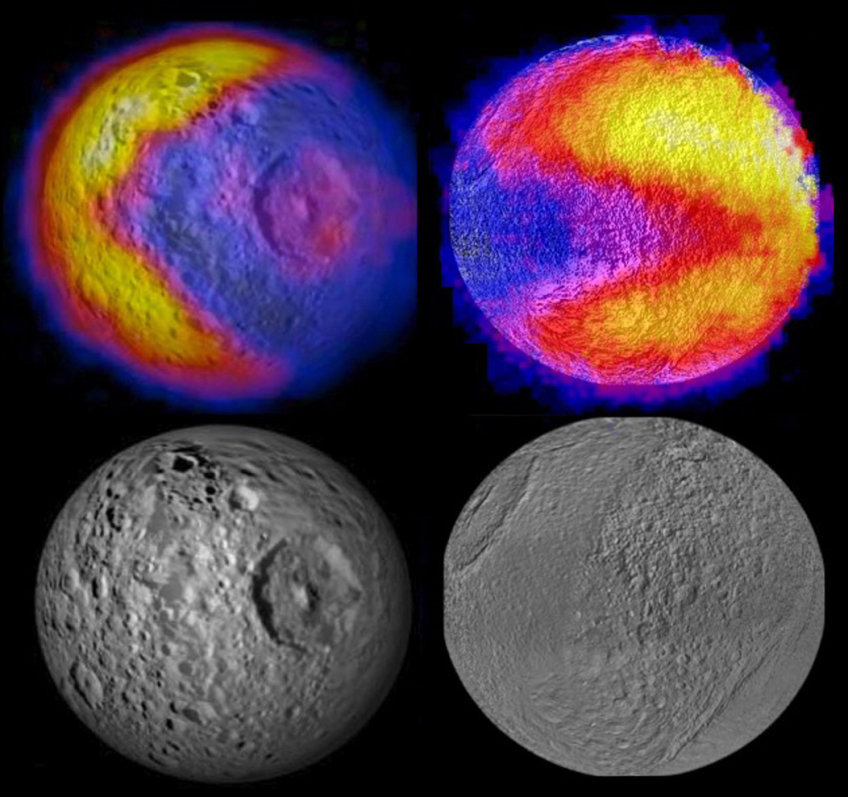When the Cassini orbiter plunges into the atmosphere of Saturn on September 15, a group of NASA scientists based in Greenbelt will be among those waiting for the spacecraft’s last long-distance ping. That bittersweet signal will mark the end of an era for the team, which has devoted two decades to operating the spacecraft’s heat-ray detector, called the Composite Infrared Spectrometer or CIRS.
NASA’s Goddard Space Flight Center is the headquarters for CIRS, and the place where the instrument was designed and built, with contributions from international partners. The Goddard team has uploaded more than 1.4 million commands to CIRS, one of 12 instruments on the Cassini orbiter. In return, CIRS has sent almost two terabytes’ worth of data and image products.
The instrument is credited with a string of scientific home runs, revealing features that were unexpected and some that were almost beyond imagination. “The Cassini mission and the CIRS instrument have been phenomenally productive, transforming our understanding of Saturn and its system,” said Goddard’s Conor Nixon, the deputy principal investigator for CIRS. Cassini was launched in 1997 and took an epic seven-year journey to Saturn, including a flyby of Jupiter. The spacecraft has spent the past 13 years investigating Saturn and its rings and moons. CIRS is one of the instruments that gives Cassini its superhuman senses. It detects light, but instead of visible wavelengths, it senses heat, or thermal infrared radiation, in much the same way hands feel the warmth of a fire.
“Using CIRS is like putting on night-vision goggles,” said Carrie Anderson, a CIRS co-investigator. “We can see in the dark. We do not need sunlight.” The value of remote infrared sensing for studying planets and moons had been demonstrated by CIRS’ immediate predecessor, the Infrared Interferometer Spectrometer, or IRIS, on Voyager 1 and 2. “CIRS was designed to be the next-generation instrument, taking IRIS’ legacy of discovery a step further,” said F. Michael Flasar, the principal investigator for CIRS. CIRS separates light into its component colors, like raindrops creating a rainbow, and measures the strength of the different wavelengths, or “colors,” of the heat rays. This allows the instrument to act as a remote-sensing thermometer and as a chemical probe, picking out radiation fingerprints of individual gases glowing in an atmosphere. The instrument does all this from a distance, while orbiting or passing by a planet. The instrument covers most of the infrared spectrum, from the last wavelengths of red light (7 micrometers) to the start of the microwave region (1 millimeter).
“CIRS is really two very powerful instruments in one, and the combination lets us push new boundaries in planetary science,” said Don Jennings, a CIRS coinvestigator. C I R S has made some stunning discoveries, such as spotting a heat signature reminiscent of the 1980s video-game icon P a c – M a n o n Saturn’s moons Mimas and Tethys. After a massive storm roiled the northern hemisphere of Saturn, CIRS tracked unprecedented hot spots and recorded an off-the-chart outburst of gas. The instrument also helped decipher the mystery of the plumes near the south pole of Enceladus, by mapping the intensity of heat along the cracks called tiger stripes.
True to its role as IRIS’ successor, CIRS is answering some questions about the atmosphere of Titan that were raised by Voyager’s studies. CIRS picked up the presence of propylene, a chemical related to propane that was mysteriously missing when Voyager detected other members of that family. The Cassini instrument also spotted a second occurrence of an “impossible” ice cloud that could not be explained by simple condensation when IRIS saw it. And CIRS witnessed a buildup of clouds above the south pole that marked the long-awaited change of seasons on Titan.
Over the years, nearly 300 scientists and engineers have worked on the instrument. This list includes the operations group at Goddard and a science team that is spread across the U.S. and Europe. Some have only been with CIRS for a few years. Others started working on the instrument concept even before the Cassini mission was selected 27 years ago. With such a long collective history, the final countdown evokes some tears for CIRS. “We’re like family on this team,” said Goddard’s Marcia Segura, leader of CIRS’ operations team. “We’re spending the last days of the mission celebrating Cassini’s wonderful life along with the public, and doing some mourning privately. As we move on to other professional challenges, the years we spent on CIRS will become precious memories.”
Activity on CIRS won’t all stop on the day of Cassini’s plunge, of course. There will be some closing out to do, and plenty of data yet to analyze. In Flasar’s view, that means the legacy of CIRS will live on. “When you build an instrument like CIRS, the knowledge gained will persist long after the spacecraft is gone,” Flasar said. “And if the mission inspires young people to pursue this kind of work, that’s a lasting contribution to science and to society.” The Cassini-Huygens mission is a cooperative project of NASA, the European Space Agency and the Italian Space Agency. NASA’s Jet Propulsion Laboratory manages the mission for NASA’s Science Mission Directorate in Washington. The CIRS team is based at Goddard. For more information about Cassini and CIRS, visit nasa.gov/ cassini/.
Elizabeth Zubritsky is a science writer working at NASA Goddard Space Flight Center.

